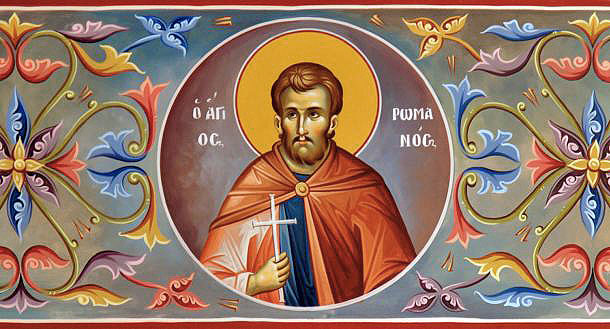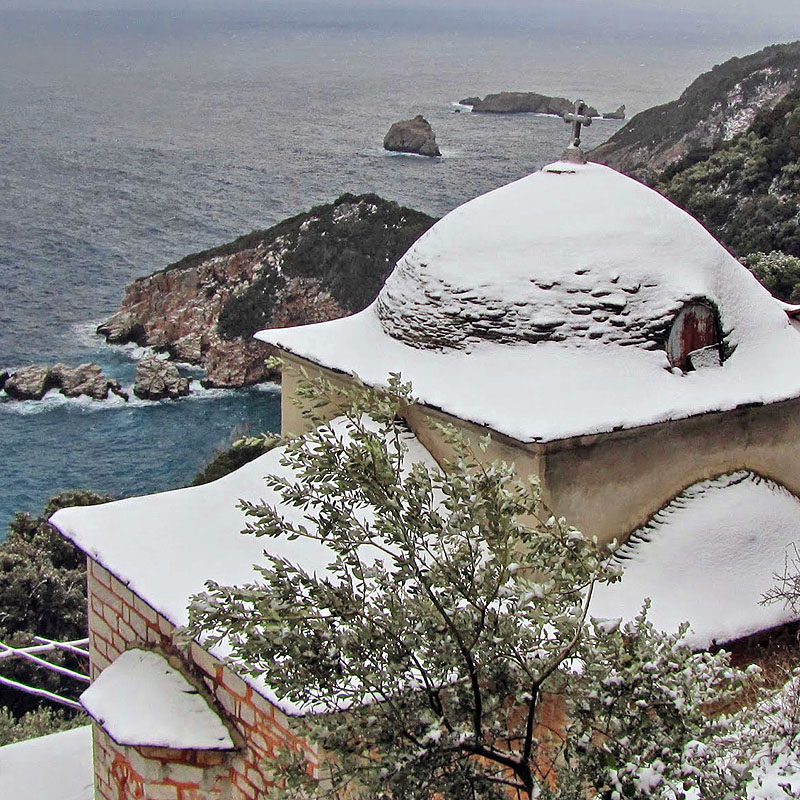Blessed Martyr Romanos, the athonite monk from Kavsokalyvia
5 January 2015The Saint was from Karpenesi. He was totally illiterate, the only thing he knew was that he was a Christian.
One day he heard that some fellows were going to venerate the Holy Tomb [of Christ in Jerusalem] and he followed them. After he venerated all of the Holy Places, he also went to the Monastery of St. Sabbas. There he heard the monks reading about the Holy Martyrs, how they suffered so many tortures for Christ in order to receive the future good things. The Saint asked what were these future good things, and when he learned from the fathers about the life to come and Paradise, the desire to receive the future goods through martyrdom hold place in his heart.
Because of this, he went to Jerusalem and shared his idea with the Patriarch, who prevented him: in case he couldn’t endure the tortures, he might deny martyrdom, while provoking the Muslims against the Patriarchate and the Christians. The blessed Romanos desired so much the martyrdom that he could not keep within himself the fire of his heart.
He therefore traveled to Thessaloniki, where he appeared before the judge, confessed Christ as true God, creator and savior of the world and called Mohammed an imposter and antichrist, and his religion an error filled with myths to laugh at. The judge ordered him to be tortured. They beat him mercilessly, they tore of strips of skin from his back, they cut his cheeks and did many other tortures to force him to deny his faith. Because the Saint remained firm in his believe in Christ, he was ordered to be beheaded.
There happened to be at that time in Thessaloniki the Admiral of the fleet who sought the judge to give him the martyr to put him in a boat, telling that this would be worse than death. Because of his position as a rower on board, he would be tortured throughout all his life, mentally and physically. the judge liked the idea and the Admiral took Romanos, cut his hair and beard and put him at the paddle.
After a short time however, some Christian friends of the captain bribed him in order to set Romanos free. Those Christians then sent him to the Holy Mountain, to the Skete of Kavsokalyvia, where St. Akakios lived. There, under Elder Akakios supervision, Romanos struggled continuously and superhumanly, but he had no peace. He lived like a stranger in this life, and he thought neither for food nor water: his mind was always at martyrdom.
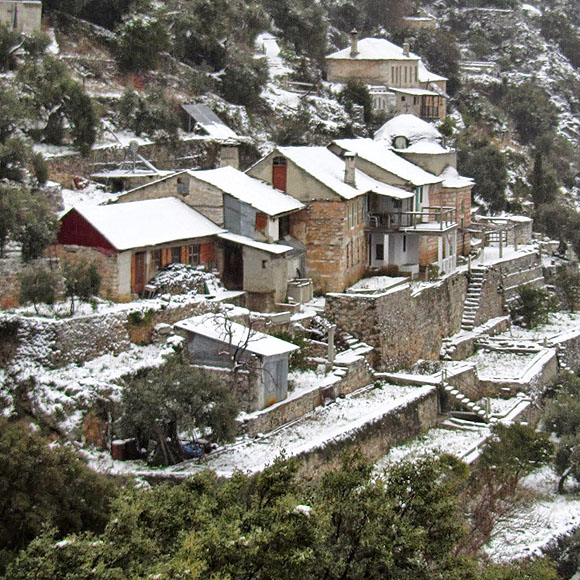
Kellia at Kavsokalivia. Winter of 2014-2015. (c) athosweblog.com
As the two of them fasted, elder and novice, St. Akakios received information regarding the favorable result of martyrdom, so he tonsured Romanos a monk and with the prayers of the fathers, he let him leave with the goal of confession and martyrdom. At first, Romanos went to Jerusalem, where he couldn’t complete his goal, because there was a fear that the Muslims would afterwards harm the Holy Tomb. Thus he traveled to Constantinople. There, he caught a little dog, tied it up with his belt and went to the bazaar. The Turks seeing this asked why was he dragging the little dog. He responded to them: “to feed him, just as the Christians feed you, Turks.” As soon as they heard this, the Turks grabbed him and brought him to the vezir, where he repeated the same words. The vezir ordered to the soldiers to torture him until he would deny his faith.
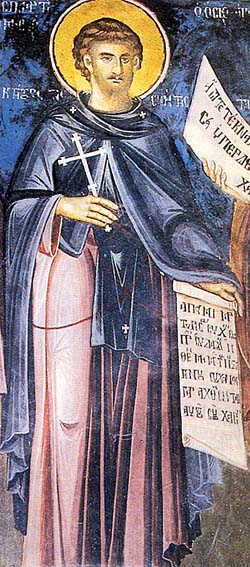
Martyr Romanos. Fresco from Holy Mountain Athos
They threw him in a wooden container, in which they usually threw murderers. There the blessed one remained without food for forty days. Later they took him out and tortured him mercilessly in various ways, without in any way convincing him to deny, so the vezir ordered him to be beheaded by sword.
As they took him to the place of execution, he greeted any Christian he saw with great joy saying that he was going to a wedding and not a slaughter, a fact that stunned many. Passing by the mosque at the hour when the hodja called for mid-day prayer, the martyr gazed and spat on him, for which cause the executioners immediately cut out his tongue, which he extended on his own for them to cut. And again he intelligently greeted the Christians with blood running from his mouth. When he reached the place of execution they beheaded him, as he thanked God and his beheaded body on its own fell towards the east, as if it were still alive. Angered by thus sign the Turks drove away the mass of Christians.
The holy relic remained three days and nights at the place of execution and the divine grace illumined it with a heavenly light, which was seen by all, Christians and Turks. In the end the relic of the martyr was bought for 500 grossi by some Englishmen who were stationed in Constantinople, and took it to England.
A napkin that was dipped in the blood of St. Romanos was offered by a pilgrim to the Monastery of Docheiariou. He later became a monk himself with the name Agapios. The Church celebrates the memory of St. Romanos on 5th of January and 16 of February.
St. Akakios’ Vision of St. Romanos
In the chapel of the Dormition of the Theotokos, of the Cell of St. Akakios, where the Righteous Martyr Romanos lived in asceticism, is depicted on the north wall a striking icon dated to 1759, from the workshop of the hieromonk Parthenios from Agrafa, whose source is the life of St. Akakios of Kavsokalyvia. It depicts the appearance of the Righteous Martyr Romanos with lightning-white robes.
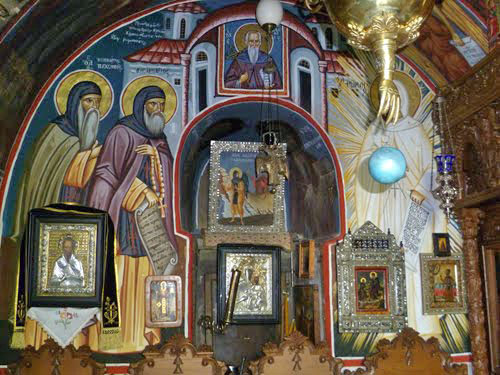
Martyr Romanos appearing before his elder, St. Akakios. Main church of the Kelli of St. Akakios
Before St. Romanos left to pursue martyrdom, he made a promise to his elder, St. Akakios, that if he was able to complete martyrdom, then he would intercede to God for his elder. St. Akakios, on his turn, would pray to God ceaselessly, until Romanos would successfully end the trial and take the crown of martyrdom. Also, Elder Akakios promised to remain in a cave until the end of his life. After the martyrdom of St. Romanos, however, St. Akakios left the cave for a few months, and descended to the Cell of St. Athanasios, just above Kavsokalyvia. He was praying there, when he came into ecstasy and saw St. Romanos shining in an indescribable manner. His face shinned more than the sun, as he was amidst the glory of God. He, however, turned his bright face from the Elder and showed his displeasure for the breaking of their agreement: Elder Akakios had left his cave. St. Akakios fell to his knees and entreated him to look upon him with sympathy and compassion and to forgive his error. St. Romanos, however, did not hearken to St. Akakios’ entreaties, and straightaway disappeared. After this, St. Akakios immediately returned to his cave in Kavsokalyvia.
Later, he many times beheld St. Romanos, drenched with the uncreated light, however, not with the same austere expression. Instead, he had a joyous and sweet expression, and he consoled and strengthened his Elder.
Apolytikion in the Fourth Tone:
You first wrestled ascetically on Athos, and received the Divine will through the teachings of the Righteous Akakios, and hastened towards the trials of martyrdom and death, and you, O Romanos, stand beside the crown-bestowing Martyr of Christ, interceding for us, O all-glorious one.
Let us honour in songs the glorious Romanos, pride of ascetics and sweetness of the New Martyrs of Christ, who at the Skete of the Lavra of Kavsokalyvia blossomed as a rose, and whom Akakios, young in years and old in asceticism, had as his own disciple.
(Ode 8 of the Canon in praise of All Saints of Athos)
Source: http://full-of-grace-and-truth.blogspot.gr/

